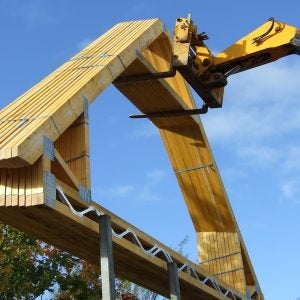The innovation combines concrete with Kerto LVL (laminated veneer lumber). The lighter weight of the hybrid sandwich wall elements proved to be a valuable benefit in the first construction project at Metsä Fibre’s Rauma sawmill.
Skanska, the constructor of Metsä Fibre’s new Rauma sawmill, has set up ambitious goals for itself as it aims to be carbon neutral globally by 2045. This has led the company to provide low-carbon or carbon neutral life-time solutions to its customers.
“We are happy to try new, innovative things and partnerships, and the use of these new hybrid sandwich elements in the new Rauma sawmill is a great example of this kind of co-operation,” said Ilkka Romo, director of the productivity and quality unit at Skanska
“The hybrid sandwich element is a great start, and the Rauma sawmill project has provided us with useful first-hand information about their use in construction,” said Mr Romo. “It seems to fit well with our technical needs. Our co-operation with Metsä Wood and Metsä Fibre has started well thanks to the expertise of these two companies.”
The element productions easy
The production of the new hybrid sandwich wall elements, which are used in the sawmill’s log sorting building, went as planned at the precast element manufacturer Lipa-Betoni’s factory. This is the first time the factory produced hybrid wall elements.
In the production of a hybrid sandwich wall element, a Kerto LVL panel forms the load-bearing core. This is followed by an insulation layer and reinforced concrete facade.
The installation of the hybrid sandwich wall elements for the first floor, 100m2, of the building took five hours.
“The assembly of the hybrid sandwich wall elements has been similar to the usual concrete sandwich elements,” said Petri Puputti, construction manager at Skanska. “We were able to use a lighter crane in the assembly as the hybrid sandwich wall elements are lighter than traditional sandwich elements. Their lighter weight can bring savings in a large construction project.”
Both kinds of elements have identical connections in the bottom, and the seams of the hybrid sandwich elements have timber screws. After the assembly of hybrid sandwich wall elements, the seams are finished and there is no need to do seaming, concrete grinding or cleaning, as is the case with concrete sandwich panels.
The sorting building will be ready by the end of this year. The sawmill is expected to be ready in Q3 2022.






